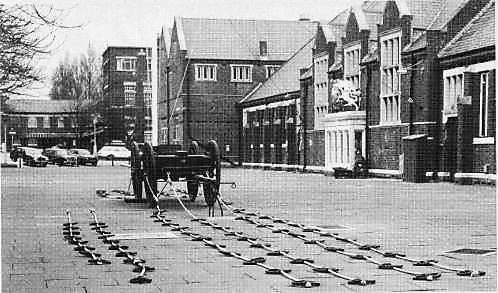- Author
- NHSA Webmaster
- Subjects
- History - general, Occasional papers
- Tags
-
- RAN Ships
- None noted.
- Publication
- March 1981 edition of the Naval Historical Review (all rights reserved)
This is of course the naval version of what happened at Windsor, and differs a great deal to what the army has to say.
Lieutenant M.L. Goldie, RHA, was the officer in charge from X Battery, and he states that the real trouble began when “an eye hole on the carriage splinter bar broke as the order to advance was given”. The ensuing confusion was worst compounded by all sorts of official and officious persons who intervened and ‘pulled rank’, preventing him from retrieving the situation by carrying out the very simple ‘Emergency Immediate Action Drill’. This was probably correct, as we have often seen high rankers get flustered at times, but Lieutenant Goldie makes no mention of the horses playing up. But then again the old horse gunners were very loyal to their ‘riders and chargers’. Another soldier reported that a certain admiral, who we will leave unnamed, as being “in high glee at scoring over the Pongos”. This could also be correct as inter-service rivalry was always high on ceremonial occasions.
Commander Mankerty leaves the final decision as to what did occur to the reader . . . “Which ever account you believe the upshot was that the Royal Navy gained the honour of drawing the Funeral Gun Carriage at the funeral of Queen Victoria and of all subsequent Monarchs and those accorded the honour of a state funeral.”

The limber seen from the front, with drag ropes laid out (photo HMS Excellent)
In 1910 the Royal Funeral Gun Carriage was presented to the Royal Navy by King George V , and since then it has been a very well respected piece of equipment. But another thought arises here. The gun had been in Naval Stores since 1901. Why? Captain Adlam stated that that was because the Royal Navy refused to give the gun back. This is quite possibly true, and it is highly unlikely that the army wanted to make any fuss after the trouble that had already taken place.
With regard to the original fiasco, Don Walker often wonders what punishment was handed out to the unfortunate drivers and horses of X Battery. No details have come to light so far, but Don visualises them as “doing endless double drills somewhere in outer space”. I personally feel strongly for Lieutenant Goldie, as he was put in a very awkward position as a very junior officer amongst the whole top brass of both services. I can understand him keeping his gun team at the ready. It was intended to be a very dignified ceremony, and possibly could have been marred by unhitching the team and taking them for a walk. Lieutenant Goldie did what probably every other officer would have done in the circumstances. Who can blame him.
The gun was kept in Whale Island suitably displayed in a brick and glass showcase on the quarter deck of the establishment. What happened to the original extemporised drag ropes is not known but the naval type drag ropes used at King Edward VII’s funeral were draped on the wall of the staff instructors’ mess at Whale Island. Besides Queen Victoria, King Edward VII, King George V, King George VI, Sir Winston Churchill and Lord Louis Mountbatten have all been carried for part of their funeral procession on the gun by men of the Royal Navy.
As a final anecdote Don Walker notes that during his time at Whale Island it was a RN sailors legend, but warns that it must be treated as such, that every time the King was reported ill the gun was “whipped out and given a polish up”.
The accompanying photographs were supplied by Commander Mankerty, and show the State Funeral Gun with the drag ropes laid out. We offer our sincere thanks to Commander Mankerty and his staff at HMS Excellent for their help in recording this incident.




